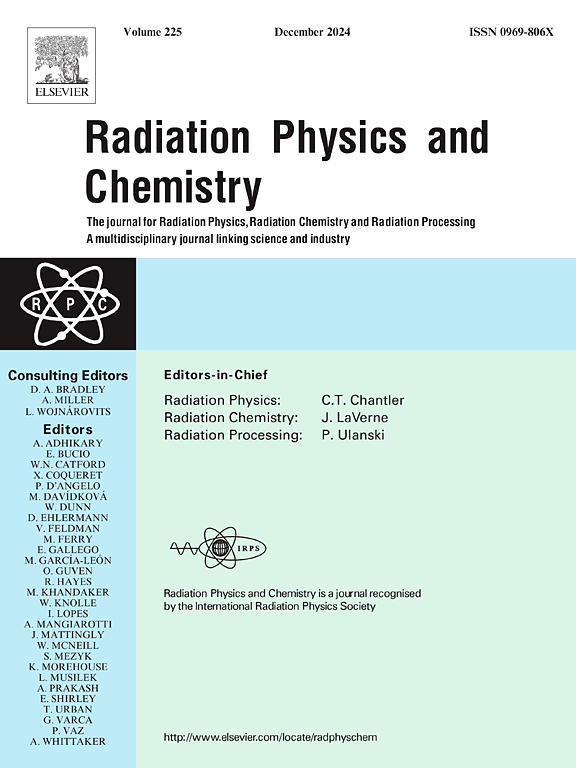ISO 4037 Narrow spectrum X-ray reference field
IF 2.8
3区 物理与天体物理
Q3 CHEMISTRY, PHYSICAL
引用次数: 0
Abstract
Characterization of the ISO-4037 narrow spectrum (N-series, “series” stands for the maximum spectral energy in keV) X-ray reference field has been performed. In details, radiometric (i.e., mean energy, spectral resolution, half-value layer, beam homogeneity coefficient) and physical (air Kerma rate) parameters have been investigated for different N-series X-ray beam qualities (i.e., N-40, N-60, N-80, N-100, N-120, and N-150) using either simulation-based and theoretical calculations or experimental measurements. In addition, the dosimetric conversion coefficients from air kerma to ambient dose equivalent and to personal dose equivalent at the normal incident angle have been deduced, and the combined standard uncertainties of investigated quantities were evaluated or estimated, whenever possible. The simulated and experimental data obtained from this work demonstrated good agreement and were consistent with reference data published in the ISO-4037 series and with those reported by the German primary standard dosimetry laboratory, indicating the reliability of the present findings. A comparison with data from other international standard dosimetry laboratories revealed a few anomalous values. It is recommended that these discrepancies should be further investigated and re-evaluated to ensure the consistency and accuracy of related calibration procedures.
ISO 4037窄谱x射线参考场
对ISO-4037窄谱(n系列,“系列”代表keV中的最大光谱能量)x射线参考场进行了表征。详细地说,辐射学(即平均能量,光谱分辨率,半值层,光束均匀性系数)和物理(空气Kerma率)参数研究了不同的n系列x射线光束质量(即N-40, N-60, N-80, N-100, N-120和N-150)基于模拟和理论计算或实验测量。此外,还推导了正常入射角下从空气克玛到环境剂量当量和到个人剂量当量的剂量学转换系数,并尽可能评价或估计了所研究量的综合标准不确定度。从这项工作中获得的模拟和实验数据显示出良好的一致性,并与ISO-4037系列中公布的参考数据和德国主要标准剂量学实验室报告的数据一致,表明本研究结果的可靠性。与其他国际标准剂量测定实验室的数据进行比较,发现了一些异常值。建议对这些差异进行进一步调查和重新评估,以确保相关校准程序的一致性和准确性。
本文章由计算机程序翻译,如有差异,请以英文原文为准。
求助全文
约1分钟内获得全文
求助全文
来源期刊

Radiation Physics and Chemistry
化学-核科学技术
CiteScore
5.60
自引率
17.20%
发文量
574
审稿时长
12 weeks
期刊介绍:
Radiation Physics and Chemistry is a multidisciplinary journal that provides a medium for publication of substantial and original papers, reviews, and short communications which focus on research and developments involving ionizing radiation in radiation physics, radiation chemistry and radiation processing.
The journal aims to publish papers with significance to an international audience, containing substantial novelty and scientific impact. The Editors reserve the rights to reject, with or without external review, papers that do not meet these criteria. This could include papers that are very similar to previous publications, only with changed target substrates, employed materials, analyzed sites and experimental methods, report results without presenting new insights and/or hypothesis testing, or do not focus on the radiation effects.
 求助内容:
求助内容: 应助结果提醒方式:
应助结果提醒方式:


